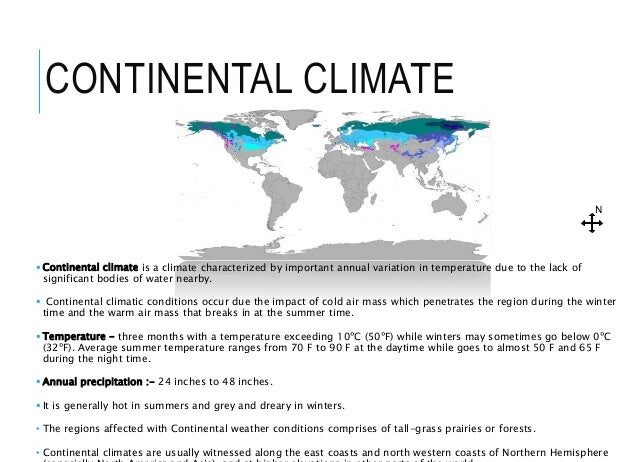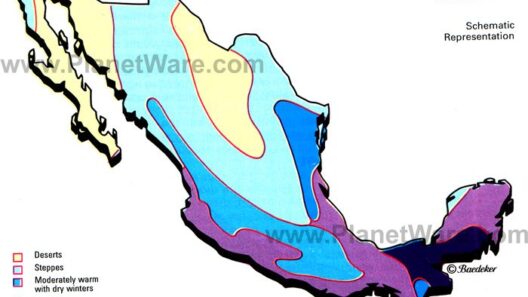Understanding the nuances of climate systems on Earth is essential for both scientific endeavors and environmental advocacy. A continental climate exemplifies the complexities and intricacies of meteorological phenomena. This climate type is primarily characterized by its distinct seasonal variations, marked by pronounced contrasts between summer and winter temperatures, resulting in a unique environmental tapestry. In this discussion, we will dissect the anatomy of continental climates, exploring their defining features, geographic distribution, impact on ecosystems, and implications for human habitation.
At the core of continental climates is a significant temperature differential between seasons. Typically manifesting in regions located inland, away from moderating oceanic influences, these climates exhibit hot summers and cold winters. While the climate classification system devised by Wladimir Köppen identifies continental climates primarily as “D” climates, it is essential to note that this broad category can be subdivided into various subclasses, such as humid continental and subarctic climates. The subdivisions hinge not just on temperature, but also on precipitation patterns and vegetation types endemic to these regions.
One of the striking features of continental climates is the stark contrast they present. For instance, in areas designated as having a humid continental climate, summers can reach sweltering temperatures exceeding 90°F (32°C), prompting lush growth in vegetation and increased biological activity. In stark juxtaposition, winters plunge to bitterly cold extremes, where temperatures can dip well below freezing. This oscillation is primarily due to the limited influence of nearby bodies of water, which typically serve to moderate temperatures in coastal climates.
Geographically, continental climates are mostly found in the temperate zones of the northern hemisphere. The United States, especially in the Midwest and parts of the Northeast, showcases quintessential examples of this climate type. Similarly, vast expanses of central Asia, notably the Siberian region, embody the extreme manifestations of continental conditions. These regions, which encompass thousands of square miles, exhibit ecosystems characterized by diverse flora and fauna adapted to the demands of fluctuating temperatures and varying precipitation.
Precipitation in continental climates is generally unevenly distributed throughout the year, with the summer months often bringing humid conditions accompanied by violent thunderstorms. However, the majority of precipitation tends to fall during this opulent season, while winters remain starkly arid. The influence of high-pressure systems during the colder months often results in a significant reduction of moisture-laden air masses, exacerbating the dryness typical to this climatic zone. This significant variation in rainfall has profound implications on the ecological integrity and health of the regional biomes.
Flora and fauna within continental climates must exhibit an exceptional degree of resilience and adaptability to cope with extreme thermal variations. Deciduous forests, such as those found in the Eastern United States and parts of Europe, thrive here, exhibiting a notable deciduous adaptation. Trees such as oaks, maples, and birches take advantage of the substantial summer light to expand their foliage, only to shed it in a synchronized response to the impending winter chill. Meanwhile, in more extreme subarctic variants, vegetation is often limited to rugged varieties like pines, which have evolved to withstand prolonged periods of extreme cold and limited nutrient availability.
From an anthropogenic perspective, the implications of residing in continental climatic zones are multifaceted. Agricultural practices are profoundly affected by the seasonal variations and precipitation distribution found within these regions. Crops that are predominantly planted during the summer months, such as maize and soybeans, thrive in the fertile soils nourished by the seasonal rains. However, farmers must also contend with the risk of early frosts in autumn or unanticipated summer droughts, which can devastate yield outputs.
Moreover, the continental climate poses challenges for urban planning and infrastructure. The construction materials and designs must prioritize thermal efficiency to withstand both the sweltering heat of summer and the frigid temperatures of winter. Energy consumption often sees stark spikes, as heating demands during winter months can triple energy needs compared to milder climates. Consequently, municipalities must adopt sustainable practices that consider the compounded effects of climate variability, energy use, and ecological integrity.
In summary, the intricacies of a continental climate offer a captivating study of nature’s extremes. The pronounced seasonal contrasts alongside diverse ecosystems set a profound stage where flora and fauna, human communities, and natural processes intertwine. The delicate balance of temperature and precipitation creates conditions that are simultaneously nurturing and challenging. Understanding this climate type opens pathways for sustainable management practices that encompass agricultural, ecological, and urban planning. As global climate patterns continue to shift, appreciating the characteristics and implications of continental climates will be essential for resilience in the face of change.






